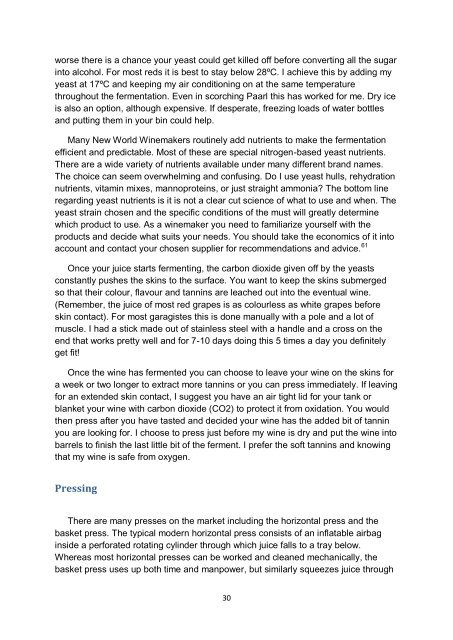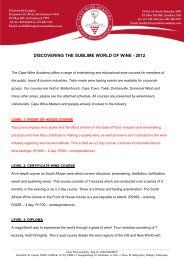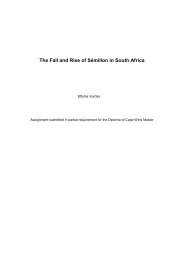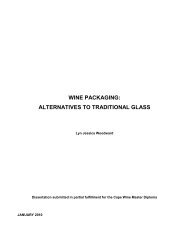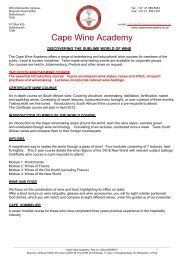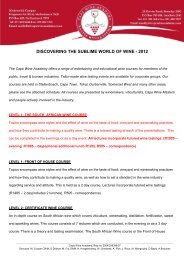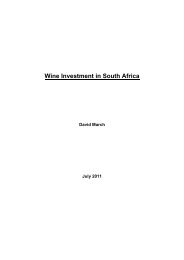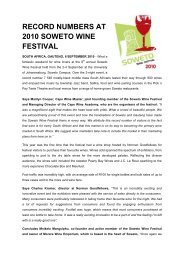Garage Winemaking in South Africa Less is More - Cape Wine ...
Garage Winemaking in South Africa Less is More - Cape Wine ...
Garage Winemaking in South Africa Less is More - Cape Wine ...
Create successful ePaper yourself
Turn your PDF publications into a flip-book with our unique Google optimized e-Paper software.
worse there <strong>is</strong> a chance your yeast could get killed off before convert<strong>in</strong>g all the sugar<br />
<strong>in</strong>to alcohol. For most reds it <strong>is</strong> best to stay below 28ºC. I achieve th<strong>is</strong> by add<strong>in</strong>g my<br />
yeast at 17ºC and keep<strong>in</strong>g my air condition<strong>in</strong>g on at the same temperature<br />
throughout the fermentation. Even <strong>in</strong> scorch<strong>in</strong>g Paarl th<strong>is</strong> has worked for me. Dry ice<br />
<strong>is</strong> also an option, although expensive. If desperate, freez<strong>in</strong>g loads of water bottles<br />
and putt<strong>in</strong>g them <strong>in</strong> your b<strong>in</strong> could help.<br />
Many New World W<strong>in</strong>emakers rout<strong>in</strong>ely add nutrients to make the fermentation<br />
efficient and predictable. Most of these are special nitrogen-based yeast nutrients.<br />
There are a wide variety of nutrients available under many different brand names.<br />
The choice can seem overwhelm<strong>in</strong>g and confus<strong>in</strong>g. Do I use yeast hulls, rehydration<br />
nutrients, vitam<strong>in</strong> mixes, mannoprote<strong>in</strong>s, or just straight ammonia? The bottom l<strong>in</strong>e<br />
regard<strong>in</strong>g yeast nutrients <strong>is</strong> it <strong>is</strong> not a clear cut science of what to use and when. The<br />
yeast stra<strong>in</strong> chosen and the specific conditions of the must will greatly determ<strong>in</strong>e<br />
which product to use. As a w<strong>in</strong>emaker you need to familiarize yourself with the<br />
products and decide what suits your needs. You should take the economics of it <strong>in</strong>to<br />
account and contact your chosen supplier for recommendations and advice. 61<br />
Once your juice starts ferment<strong>in</strong>g, the carbon dioxide given off by the yeasts<br />
constantly pushes the sk<strong>in</strong>s to the surface. You want to keep the sk<strong>in</strong>s submerged<br />
so that their colour, flavour and tann<strong>in</strong>s are leached out <strong>in</strong>to the eventual w<strong>in</strong>e.<br />
(Remember, the juice of most red grapes <strong>is</strong> as colourless as white grapes before<br />
sk<strong>in</strong> contact). For most garag<strong>is</strong>tes th<strong>is</strong> <strong>is</strong> done manually with a pole and a lot of<br />
muscle. I had a stick made out of sta<strong>in</strong>less steel with a handle and a cross on the<br />
end that works pretty well and for 7-10 days do<strong>in</strong>g th<strong>is</strong> 5 times a day you def<strong>in</strong>itely<br />
get fit!<br />
Once the w<strong>in</strong>e has fermented you can choose to leave your w<strong>in</strong>e on the sk<strong>in</strong>s for<br />
a week or two longer to extract more tann<strong>in</strong>s or you can press immediately. If leav<strong>in</strong>g<br />
for an extended sk<strong>in</strong> contact, I suggest you have an air tight lid for your tank or<br />
blanket your w<strong>in</strong>e with carbon dioxide (CO2) to protect it from oxidation. You would<br />
then press after you have tasted and decided your w<strong>in</strong>e has the added bit of tann<strong>in</strong><br />
you are look<strong>in</strong>g for. I choose to press just before my w<strong>in</strong>e <strong>is</strong> dry and put the w<strong>in</strong>e <strong>in</strong>to<br />
barrels to f<strong>in</strong><strong>is</strong>h the last little bit of the ferment. I prefer the soft tann<strong>in</strong>s and know<strong>in</strong>g<br />
that my w<strong>in</strong>e <strong>is</strong> safe from oxygen.<br />
Press<strong>in</strong>g<br />
There are many presses on the market <strong>in</strong>clud<strong>in</strong>g the horizontal press and the<br />
basket press. The typical modern horizontal press cons<strong>is</strong>ts of an <strong>in</strong>flatable airbag<br />
<strong>in</strong>side a perforated rotat<strong>in</strong>g cyl<strong>in</strong>der through which juice falls to a tray below.<br />
Whereas most horizontal presses can be worked and cleaned mechanically, the<br />
basket press uses up both time and manpower, but similarly squeezes juice through<br />
30


